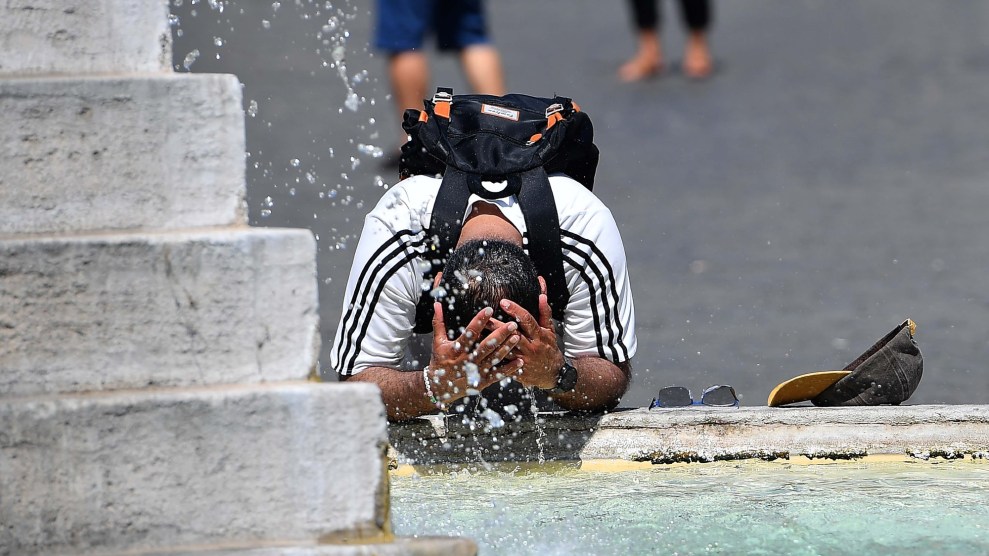The mere fact of tomorrow’s presidential elections in Afghanistan is cause for (subdued) celebration. Afghans are headed to the polls in the country’s first-ever “democratic” election, and early indications are that an overwhelming percentage of eligible voters (conceivably, more than 100 percent!), including an impressive number of women, have registered.
And yet, notwithstanding the happy spin put on the vote by the Bush-Cheney campaign — not to mention the echoing chorus of the mainstream media — the validity of this election remains in question. For one thing, the basic physical security of voters is impossible to guarantee. Still, the Bush administration needs there to be elections in Afghanistan before Nov. 2, and so elections there will be — ready or not.
Unfortunately, there are plenty of signs that Afghanistan is not quite ready. Consider: a new poll finds that 87 percent of Afghans believe women need to ask their husband’s permission to vote, with not much separating the opinion of men and women. According to Human Rights Watch, the situation is even more dire for women in southern Afghanistan:
According to official tallies, 41 percent of 10.5 million registered voters in Afghanistan are women. But closer examination reveals that multiple registrations have inflated voter registration figures. In some areas, fear of attacks has prevented mobile registration teams from going door-to-door, a critical means of reaching out to women in rural or conservative areas. These factors contributed to appallingly low female registration rates in the south: In Uruzgan province, 9 percent of registered voters are women; in Zabul province, the figure is 10 percent; in Helmand province, 16 percent in Helmand province.
The problem of multiple registration is well documented, and borders on the absurd. As Christian Parenti explains explainsin The Nation:
I have two valid voter-registration ID cards and I am a foreign journalist. If a friendly party (like the one who gave me the cards) controls my polling station, I’ll be able to vote twice because there is no reliable system for verifying the identity of voters. In four heavily Pashtun provinces along the eastern border with Pakistan, more than 140 percent of the adult population is registered to vote.
Another problem is voter intimidation. The European Union and the Organization for Security and Cooperation in Europe inititally declined to send in election monitors, concerned that they could not determine the vote free and fair. In the end, they sent 125 monitors who are confined to Kabul.
A larger question is whether Afghans are ready to express themselves with the ballot rather than the bullet. Hamid Karzai, the incumbent and U.S.-backed candidate, remains confined to Kabul, virtually unable to campaign outside his compound due to threat of assassination. His vice presidential running mate, Ahmed Zia Massood, survived an assassination attempt on Wednesday. And today, today security forces in the southern Afghan city of Kandahar thwarted an attack that could have killed hundreds of people. Violence is grimly expected at some of the 25,000 polling stations in 5,000 locatiions across the country.
But what is an election at this time in fact deciding, and what are it’s actual costs? For many observers, in Afghanistan and abroad, the election comes at a difficult time for the country’s economy. Here’s Barnett Rubin, an Afghanistan expert at New York University:
Elections are the most complex operation a government carries out in peacetime. Almost all the adult population is registered with the state for the first time. There has never been a census. The elections are costing $100 million, or 20 percent of the budget or half of the government’s revenue.
And the actual costs of the election will amount to another $100 million. All for an election that most agree will remain unofficial until at least the end of October.
The presidential election in Afghanistan is being claimed by the Bush administration as vindication of its foreign policy choices. And it’s to be hoped that, despite widespread fears, the elections go off peacefully and with some legitimacy.
But, as the Economist points out is more than a matter of holding elections:
Whether Mr. Karzai, or whoever is elected president, will eventually calm the parts of Afghanistan beyond the control of Kabul remains to be seen. The first clue should appear in the line-up of the new government. A smaller, cleaner cabinet, and fewer drug-peddling provincial governors, would look good to many Afghans. The same line-up, mostly a rabble whose jobs have been secured by pre-election pacts, would not. Afghans know little about democracy. But, after their experiences of communism and Islamic fundamentalism, they know when they are being sold a dud.















